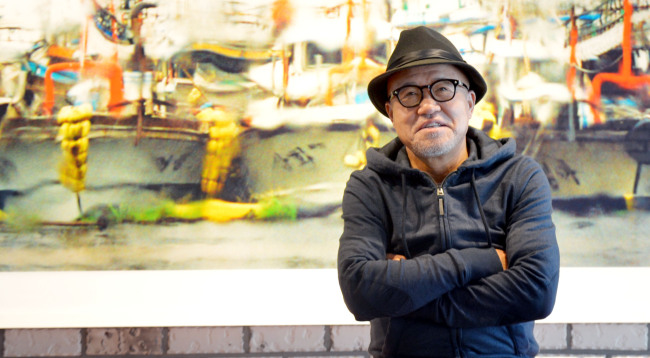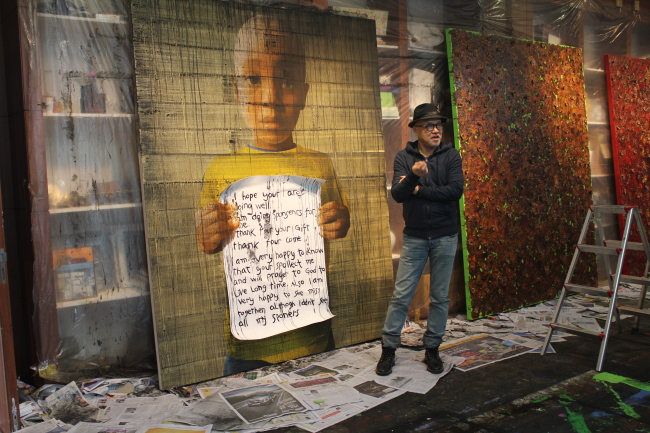
The office floor of Kim Chang-il, chairman of Arario Group, is strewn with artworks like a statement of his life as an art lover. Four stuffed deer studded with glass balls, an artwork of Japanese artist Kohei Nawa, greet visitors. Then the onlooker’s gaze is naturally drawn to a large photograph hanging in the reception room, and then to more photographs and paintings in other rooms, all of them seen through glass walls.
Kim, 63, who boasts a number of occupations ― a businessman, an art collector, an owner of galleries and an artist ― points to the large photo of fishing boats. “I took this in Jeju. To get a nice-looking one, I had to release my camera shutter hundreds of times,” he said. His dark blue cotton sweatshirt, jeans and fedora gave off the free-spirited vibe of an artist, far from that of a businessman.
He spends the majority of his time these days in Jeju to set up a milestone of what he’s been doing for nearly three decades. After months of a meditative stay in Jeju to seek the meaning of art and beauty, the multimillionaire, who was one of the world’s top 200 art collectors as selected by ARTnews, made up his mind to pursue his long-cherished dream of owning a museum.
One day, when he was preoccupied with a project to open a museum in Jeju by October, an early modern-style building struck him as an attractive candidate site last November. Kim made the instant decision to purchase it just a day after learning from a news report that no one had bid for the building that was put on auction. He bought the building, which had been used as the headquarters of architecture firm Space for 15 billion won, and named it Arario Museum in Space.
“Ever since I started my business, I have never stopped dreaming of owning a museum,” said Kim.
Foretold to become rich
Kim found entrepreneurial success running a small convenience store at the old Cheonan bus terminal at age 27. His business has grown by leaps and bounds ever since he earned some 100 million won in the first year. Now he owns the Shinsegae department store, a movie theater and galleries.
Still, he doesn’t really understand how he got this far in business, he said.
“No one taught me how to run a business,” said Kim. “But I guess I subconsciously thought I should become a businessman and make a lot of money, possibly because I was almost brainwashed by my grandparents from early on that I would become a successful businessman,” he said.
It was none other than his nose that made his grandparents believe so blindly that he would succeed economically.
“My grandparents often told me that I would become superrich because I have a round nose,” he said. In Korea, a round nose is phrenologically interpreted to bring fortune.
Kim visited fortunetellers in Jongno, Seoul, after he graduated from college. What he heard was surprisingly the same: They told him that he would become a successful businessman.
Looking back, though, he attributes his success to the bumpy road he had to take in his early adulthood, rather than to physical attributes.
He failed his college entrance exams for two straight years, which devastated him psychologically.
“I felt very inferior to my friends who earned admissions to presigious schools without failure. My life since then wasn’t smooth. I got assigned to the honor guard of the Korean Army, which was notorious at that time for frequent violence in the barracks,” Kim said.
His years spent in the military were the most challenging of his life. Kim, who was filled with anger, frequently got involved in fights on the streets.
“The worst came when I was dispatched to the unit for my mandatory military service. I cursed heaven countless times whenever my superiors gave me a hard time while most of my high school friends served their time comfortably at administrative divisions,” Kim said.
“What I had gone through has made me strong in pushing my business further,” he noted. “People learn from those experiences and mistakes. Eventually, they lead you to make better decisions in business and in life.”
Reflecting life through art

Kim’s love for art budded in 1981 when he went to Los Angeles to introduce himself to his future in-laws with his girlfriend, who’s now his wife. One of the places his sister-in-law took him to was the Museum of Contemporary Art, Los Angeles. He calls it a “life-changing place.”
“Little did I imagine such a world existed,” Kim said. “The Oldenburg sculptures, Marcel Duchamp and Picasso works on display at that time are still vivid in my mind,” he said.
The museum image in his memory gave him inspiration to push for art projects in combination with his flourishing business. The sculpture park in front of the Shinsegae department store now displays some world-famous works of art, including Damien Hirst’s “Charity” girl statue, Armand Fernandez’s “Millions of Miles” and Kohei Nawa’s “Manifold.”
He began to buy artworks out of pure art motifs, unlike other rich art collectors in Korea who make purchases as a means of investment. His decisions were spontaneous, depending on whether or not he liked the work.
“Then I began to feel people were looking down on me because I had little knowledge about art,” he said.
The next thing he did was to memorize what was written in contemporary art books. He says he still likes “picture books” that show pictures of artworks together with artists’ simple explanations.
He reached ARTnews’ list of the world’s top 200 art collectors for seven years in a row. His purchase of artworks has had a clear impact on the international art scene, as he owns many works of the British Young Artists next to Charles Saatchi and works of the German Leipzig School.
Of some 3,700 pieces of works, some will be showcased at his museum scheduled to open this fall.
In 1999, he took a step further and started to create art on his own. He has painted and used everyday objects to create installations and even sculptures under the nickname “CI Kim.” Drawing from images of his favorite artworks, he creates works that share some characteristics of the world’s famous artists. Like Marcel Duchamp, he collects objects that are meaningful to him. Sometimes, the use of objects is as creative as that of artists. He throws ripe persimmons and tomatoes onto painted canvases and watches them rot.
His experiments with art also reflect his spontaneous personality and quick decision-making in business. “I am not a rational person. Many of my decisions are made with instinct and a hunch. If I have an idea, I turn it into an action right away,” Kim said.
When he decided to buy the historic Space building, it took an hour and a half to reach the final decision. Though it might seem superficial, he said, his intensive meditation and energy are the sources of his accurate hunch.
Kim’s next step is to test the power of art that he kept to himself and share it with the public. The first project will be unveiled this fall, in time for the opening of the Arario Museum in Space in Seoul. Kim will renovate long-neglected buildings, display artworks there and see how art transforms the abandoned place and their neighborhood.
The second project is opening a museum in Jeju, which is part of his journey to explore the meaning of art and beauty.
“I thought very deeply about the meaning of art and its beauty, and my answer is, art should have soul and sentiment,” Kim said.
By Lee Woo-young (wylee@heraldcorp.com)


















![[Today’s K-pop] Treasure to publish magazine for debut anniversary](http://res.heraldm.com/phpwas/restmb_idxmake.php?idx=642&simg=/content/image/2024/07/26/20240726050551_0.jpg&u=)